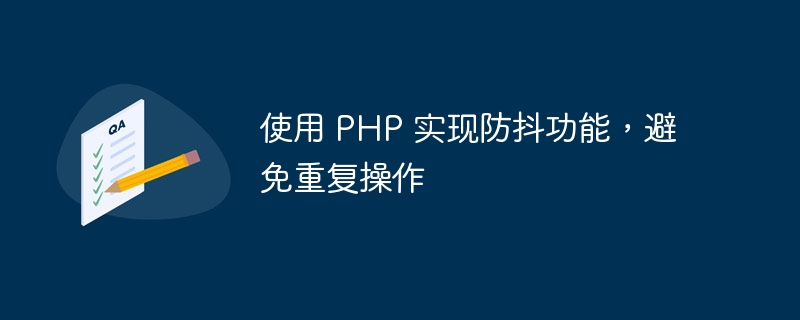Home >Backend Development >PHP Tutorial >Use PHP to implement anti-shake function to avoid repeated operations
Use PHP to implement anti-shake function to avoid repeated operations
- PHPzOriginal
- 2023-10-12 10:27:11969browse

Use PHP to implement the anti-shake function to avoid repeated operations. Specific code examples are required
Title: PHP anti-shake function implementation example
Anti-shake is A technology commonly used on the front end, it can effectively avoid triggering events or requests repeatedly in certain specific scenarios. This article will introduce how to use PHP to implement anti-shake function and provide specific code examples.
The principle of anti-shake is very simple. When an event triggers multiple times within a specified time, only the last triggered operation will be executed. This is very useful in many scenarios, such as button click events, input box input events, etc. Below we will use PHP to implement a simple anti-shake function.
First, we need to define a global variable to record the timestamp of the last trigger event, and then define a specified time interval. The following is a sample code:
<?php
// 定义全局变量
$lastTime = 0;
$debounceTime = 1000; // 指定的时间间隔,单位为毫秒
// 防抖函数
function debounce($callback) {
global $lastTime, $debounceTime;
// 获取当前时间
$currentTime = microtime(true) * 1000;
// 判断时间间隔是否满足防抖条件
if ($currentTime - $lastTime >= $debounceTime) {
$lastTime = $currentTime;
$callback();
}
}
// 示例回调函数
function handleClick() {
echo 'Button clicked!';
}
// 模拟按钮点击事件
debounce('handleClick');
?>In the above code, we define a global variable $lastTime to record the timestamp of the last triggered event, using $debounceTime Variable specifies the time interval.
Then, we define a function named debounce, which receives a callback function as a parameter. Inside this function, we get the current time and determine whether the anti-shake conditions are met by calculating the time difference between the current time and the last trigger event.
If the conditions are met, update the $lastTime variable to the current time and execute the passed callback function.
Finally, we defined an example callback function handleClick, in which a message was printed.
The debounce('handleClick') code in the last line simulates the button click event and calls the debounce function, passing in the handleClick function as a parameter to achieve the anti-shake effect.
The above code is just a simple example and can be modified and expanded according to actual application scenarios. I hope this article can help you understand and use PHP to implement anti-shake function.
The above is the detailed content of Use PHP to implement anti-shake function to avoid repeated operations. For more information, please follow other related articles on the PHP Chinese website!

